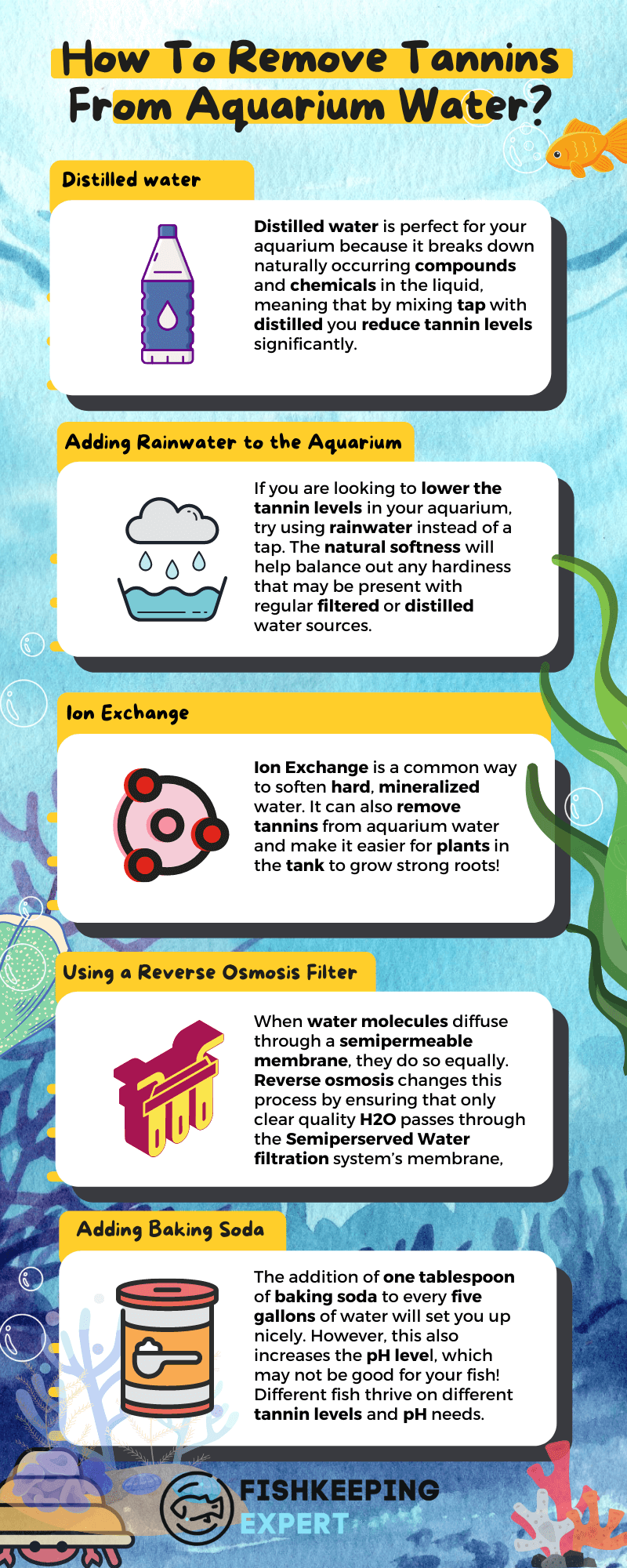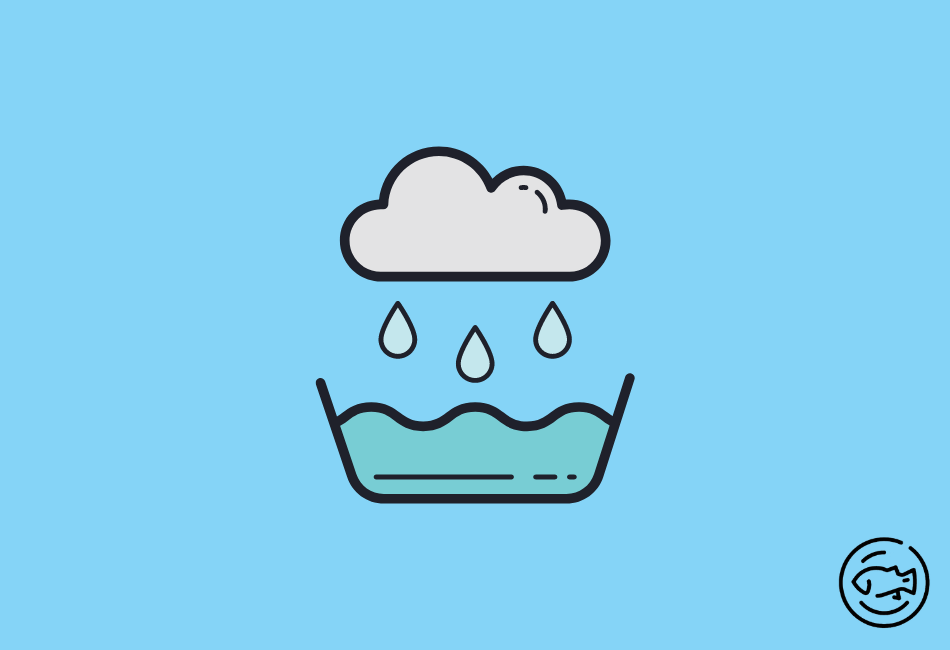The discoloration of your aquarium water is most likely due to the amount of tannin in it. Some fish do better with this, while others aren’t as lucky and need less or no such influence!
Aquarium hobbyists have been known to try and reduce or remove tannins from aquarium water. This is because it can be unsightly, so some people choose not to let this get them down!
How To Remove Tannins From Aquarium Water?
One way to remove tannins from aquarium water is by using activated carbon. This will absorb the harmful substances in it and leave only pure, safe H2O for fish to swim around happily while isolated from all those harsh elements outside their natural habitat!
Activated carbon is an important tool in the fish tank because it can remove tannins responsible for giving bad tastes and smells.
The activated charcoal granules have been altered on a chemical level to make them more absorbent; this allows activated carbons’ binding properties with water molecules. They suck up all kinds of other pollutants that might otherwise settle onto your fish’s fins or skin!
Adding activated carbon remove tannins in a few hours, but this isn’t necessary if you have an aquarium filter with quality components.
If you discover that your tank has high tannins than the routine, it may be time to replace the filter.

Why You Should Remove Tannins From Aquarium Water?
The type of clear water you use will determine how much tannin needs to be removed.
The pH and alkalinity of your fish’s environment will change with tannins. You can see a brownish or yellowish tint in your tank if an excessive amount of tannin is present in it. This is good for some types, but not others!
The presence of tannins in water that traverses marshy or overlapping areas with plant and animal decay is not uncommon.
Tannins are naturally occurring in organic matter so they can be found on plants and animals.
Different Methods To Remove Tannins From Aquarium
Tannin can be a stubborn residue in your aquarium water. However, it’s possible to remove this unwanted element with the following tips:
Distilled water

The first step in removing tannins from aquarium water is to soften it with a 50/50 mixture of tap and distilled.
Distilled water is perfect for your fish tank because it breaks down naturally occurring compounds and chemicals in the liquid, meaning that by mixing tap with distilled you reduce tannin levels significantly.
So, you can use the Distilled water to adjust the tannins levels inside most aquariums.
Adding Rainwater to the Aquarium

If you are looking to lower the tannin levels in your aquarium, try using rainwater instead of a tap.
The natural softness will help balance out any hardiness that may be present with regular filtered or distilled water sources, and it’s also more acidic, which can favorably affect pH balance scorecards!
Managing rainwater for an aquarium is not an as simple task. You can’t just stick a tub under the nearest eaves trough or drain pipe!
To ensure that you can collect rainwater in an aquarium, it is important that:
- The drainpipes of your house or building’s plumbing system are not metal and have a clear path so water can flow freely out into low-pathogenic areas.
- Make sure there isn’t too much atmospheric pollution around where this will go because those particles could end up getting trapped within them instead!
Give your rainwater a few minutes to clean out the drain pipe before collecting it. This will reduce any dirt or other particles that may be in there and make for better aquarium water quality!
When adding rainwater into an aquarium, one important thing to keep in mind is that your tank will have a lower level of tannins than tap water because it bypasses the organic material that produces tannins.
This is how you can add rainwater to your aquarium and absorb tannins present in it.
Also Read: What Is Dragon Stone for Aquarium?
Ion Exchange

Ion exchange is a common way to soften hard, mineralized water. It can also remove tannins from aquarium water and make it easier for plants in the tank to grow strong roots!
Ion exchange is a process that changes the properties of ions by replacing them with similarly charged ones.
The negative charges of tannins attract anion resins, which replace them with similarly-charged ions.
However, these do not possess the same water softening properties as their counterparts from before treatment because they’re now positively charged instead.
The benefits of anion resin treatments for aquarium water are two-fold. Not only does it remove tannins, but also it doesn’t remove any mineral nutrients that most fish need to survive!
However, anion resins can chemically alter your aquarium water’s pH or chloride levels.
Hence, you’ll want to keep an eye on the composition of your aquarium water parameters so that it is comfortable for your fish.
This is the method where we use the Ion Exchange to lower the number of tannins in your tank and maintain a peaceful environment for your fish.
Using a Reverse Osmosis Filter

You can also utilize a reverse osmosis filter to lower the tannin in your aquarium.
When water molecules diffuse through a Semipermeable membrane, they do so equally. Reverse osmosis changes this process by ensuring that only clear quality H2O passes through the Semiperserved Water filtration system’s membrane, perfect for those looking to maintain the tannin levels in their aquarium.
The water in your aquarium will be softer and clearer because any additives like tannin present before filtering have been eliminated.
This is the method of the reverse osmosis filter through which you can remove tannins from aquarium water.
Adding Baking Soda

It is common knowledge that to de-tannin your teapot, you can simply rinse it with baking soda. The same thing happens when you use your aquarium’s water and add baking soda to it.
The addition of one tablespoon of baking soda to every five gallons of water will set you up nicely. However, this also increases the pH level, which may not be good for your fish!
If you decide to use baking soda, do your research first! Different fish thrive on different tannin levels and pH needs.
To ensure that the fish in your aquarium live a healthy life, it’s essential to test and adjust pH levels in the aquarium to achieve a habitable environment for the fish.
Baking soda is a great way to reduce tannin levels in your tank water. You should remove any fish before lowering the pH level with it, though.
The use of Baking Soda should be done with the consideration that it will increase the pH level inside the aquarium. So, therefore, use it carefully or under the supervision of an expert.
Avoid Adding Excessive Decorations to your Aquarium

All fish tank lovers enjoy decorating their tanks with decorations. But not all of them are created equal!
This is an important consideration if you are trying to recreate the natural environment of a particular fish or want less tannin in your water.
Driftwood is a great addition to your tank if you want clearer, softer water. The natural tannins in driftwood release helpful chemicals that aid with this goal!
To ensure that your aquarium water is safe for fish and not too strong in tannin levels, avoid adding any of the following items, which can increase both: Driftwood, Oak leaves, Indian almond leaves, and Peat.
Avoid adding them because their tannin levels can increase and make it more difficult for you to maintain a stable environment inside your aquarium.
Do not add unnecessary aquarium-related products inside your aquarium as it can become crowded for the fish mates inside.
When Do You Need Tannins in your Aquarium?
It’s easy to get rid of tannins in your aquarium, but it may not be the best idea. Some fish come from blackwater or have water with high levels of organic compounds necessary for their survival – if you remove tannins completely, this could ultimately harm your fish.
When removing tannins from your aquarium, make sure you do it only when necessary and always with the goal of improving water quality and not just for developing an aesthetically pleasing aquarium.
When fish live in natural habitats with lots of tannins, they’re most colorful. The beauty and diversity among different species are breathtaking!
For instance, the Amazon & Congo has many types that are vibrant because it’s richly stocked with these natural chemicals.
Many fish find the perfect breeding ground in tannin-heavy water. Therefore, it’s worth forgoing the filter for some fish if you’re hoping to raise more of that particular type.
So, it depends on you about what type of environment you want to sustain for the fish mates inside your aquarium.
Conclusion
Tannin in crystal clear tank water can have a lot of benefits for fish, but not everyone likes the color, and some types only need brackish or tannin-rich water to survive.
You can use various methods to remove tannin from aquarium water, but some will take more time than others.
PH balancing is an important part of caring for your fish. Keep a close eye on the pH level so that you can avoid shocking your fish with sudden changes in acidity or alkalinity!
Lastly, to avoid an unclean aquarium, choose plants that don’t produce tannin, and you will be rewarded with the excellent water clarity.
So, this is the process on how to remove tannins from aquarium water.
Hope you liked it, and if you have any questions, then you can ask them in the comments section below!


